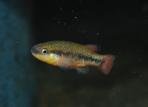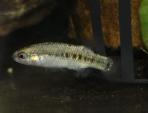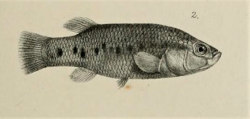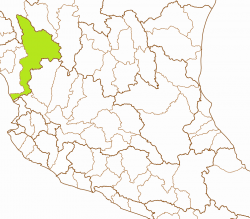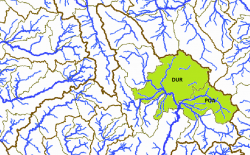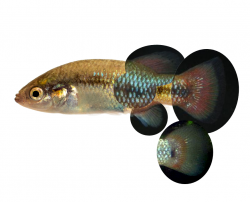Characodon lateralis
GÜNTHER, A. (1866): Catalogue of the Physostomini. Catalogue of Fishes of the British Museum 6: pp 1-368
Collection-number (probably): British Museum of Natural History, Cat. No. BMNH-1855-9-19.
The Holotype is a female of 56mm total length, collected with eight additional specimens by Berthold Carl Seemann. Concerning type locality and date of collection, see the following chapter.
The left picture show a drawing of one of the types of Characodon lateralis, the right one two specimens Miller used in his description of Characodon audax for comparison:
Following Günther, the Holotype comes from "Central America", but this is definitely not precise enough, as he mentioned, that four of the fish he got for the British Museum, were part of B. C. Seemanns collection, whereas five more came from a collection of the Haslar Hospital Museum, but originated in the same collection of Seemann (J. Richardson, 1852). Seemann, who was botanist and appointed naturalist on a voyage of the HMS Herald from 1847-51, undertook a road trip during this journey from Mazatlán to Durango (23.11.1849-02.01.1850). That day in January he left the city of Durango and went southwards, reaching the town of Mezquital three days later on January the 5th. In this three days' period he must have collected the types of Characodon lateralis, and he collected them along this road.
Here a few sentences out of his narrative about the whole voyage, concerning his road trip from Durango to Mezquital (Narrative of the voyage of H.M.S. Herald during the years 1845-51, under the command of Captain Henry Kellett... being a circumnavigation of the globe, and three cruizes to the Arctic regions in search of Sir John Franklin, B. C. Seemann, about Durango: pp: 159-174): "My original plan was to visit Chihuahua. The principal reason which induced me to alter the route was the season. [...] I therefore took a south-western direction, the road to Tepic. Departing from Durango on the 2nd of January, 1850. I reached on the 5th instant, Mesquital, a considerable village, [...]. I collected however a good many specimens, the vegetation not having suffered so much from frost as in that part of the Sierra Madre which I crossed when coming from Mazatlan."
The problem, taxonomist face now is easy to explain with the following map: the red line is the road Seemann used, the green arrows show the ways he came to and left from the city of Durango. So far, so clear, but now there is a problem with that road: It doesn't meet any watershed with fish we call Characodon lateralis (blue circle). Again, it meets the Arroyo La Estancia next to Pino Suarez (violet bar), a creek which is inhabited by a population of Characodon, we label as audax today, so the conclusion out of that is, that the type location of Characodon lateralis is highest probably this creek, or another one close by, that the group with Seemann crossed before. Therefore we would - properly speaking - have to label Characodon audax as lateralis, and Characodon lateralis as a "to be described" species (Artigas-Azas, 2014). But there is actually a study in cooperation with the GWG in process (Piller et al.) to solve the phylogenetic relationship of all known Characodon populations (including C. garmani), so until this study isn't finished, it is better to keep it as it is to prevent anymore confusion. We should however expect future changes (see also Characodon audax and garmani).
The left picture shows the probable travel route of Seemann to and from Durango city (map legend in the text above), the right picture the Cascada el Saltito, the waterfalls separating the two Characodon species of Durango and located close to the habitats of Characodon lateralis. Seemann was a very sharp observer and accurate describer of what he saw. It is hard to believe he took a way that brought him to the waterfalls and further on the habitats of the Rainbow Goodeid without even mention this impressive natural wonder. The only explanation is, he indeed took the road shown on the left map:
The species name is derived from the Latin with the word "latus" meaning side and "lateralis" meaning located on the side. The epithet refers to the lateral stripe in the colour pattern of this fish, mainly visible in preservation.
The genus was erected by Günther in 1866. He didn't explain why he had chosen this name, but it is obvioulsy refering to the typical dentition. The name of the genus can be derived from the ancient Greek with Χάραξ (chárax), meaning "a pointed stake" and ὀδόντος (ódóntos), the genitive of ὁδούς (ódoús), the tooth. So the name of the genus can be translated with "a tooth like a pointed stake".
Characodon garmani Meek, 1904
The Rainbow Goodeid is endemic to the federal state of Durango. It is historically known from an area directly north of the town of Nombre de Díos encompassing the Río La Villa and the Arroyo Las Compuertas including some large springs like the Ojo de Agua Los Berros and the Ojo de Agua de San Juán. Furthermore it was known from a spring and its effluent in Amado Nervo, that drains into the Arroyo La Ciénega, an affluent of the Río La Villa in Nombre de Díos. It disappeared from Amado Nervo due to a heavy drought and from several other historically known places like the Ojo de Agua de San Juán, probably due to exotic fish species. It is actually known from the springs in Los Berros and a tiny spring on a private property in La Constancia. Two subpopulations, the Los Berros subpopulation (type subpopulation) and the Amado Nervo subpopulation are distinguished. The second one is regarded Extinct in the Wild. The bold names are the ones officially used by the Instituto Nacional de Estadística y Geografía; nevertheless, other ones might be more often in use or better known and therefore prefered.
ESU ist short for Evolutionarily Significant Unit. Each unit expresses an isolated population with different genetic characteristics within one species. ESU's can be defined by Molecular genetics, Morphology and/or Zoogeography and help in indicating different phylogenetic lineages within a species. The abbreviation for an ESU is composed of three letters of the genus, followed by the first two letters of the species name and an ongoing number in each species.
Within Characodon lateralis we are able to distinguish two ESU's. We use the ESU abbrevaitions given by John Lyons, who groups them as Characodon sp. as he wants to wait for final studies. The first one, Chrsp8 is in use for the fish of the more northen and bigger area of distribution, including populations of springs in San Juan, Los Berros, La Constancia and Nombre de Díos. Some of these populations are extinct, but at least the ones in Los Berros and La Constancia remained. The second ESU, Chrsp9 was found in a small spring and its outflow in Amado Nervo, a small town east of Nombre de Díos. It has to be treated as extinct in the wild.
The left map shows the Río San Pedro basin from the Hydrographic Region Presidio-San Pedro on a Mexico map. The Rainbow Goodeid is known from the ríos Durango (DUR) and Poanas (POA) subbasins, both Río San Pedro basin and shown on the right map. Chrsp8 is known from the Río Durango subbasin and Chrsp9 from the Río Poanas subbasin. This last ESU is probably Extinct in the Wild:
International Union for Conservation of Nature (IUCN): Critically Endangered
Distribution and current conservation status of the Mexican Goodeidae (Lyons et al., 2019): Critically Endangered/declining: „The taxonomy and relationships of the Characodon populations occupying the upper Tunal and Durango river drainages in the upper Mezquital River basin in the state of Durango are currently unresolved. Originally, a single species, C. lateralis, was recognized, which occupied a series of semi-isolated spring systems near the city of Durango. However, the locality given for the original collection of the species, “Central America”, was clearly erroneous and the type material could not be attributed to a specific spring system (Miller et al., 2005). In the 1980’s, the population in the springs near the town of El Toboso was described as a separate species, C. audax, based on morphology, with the remaining populations considered C. lateralis (Smith and Miller, 1986). However, more recent genetic analyses revealed little difference between the El Toboso population and other nearby Characodon populations (Doadrio and Domínguez-Domínguez, 2004; Domínguez-Domínguez et al., 2006). Instead, these analyses indicated that populations from spring systems located above the El Salto Waterfall on the Tunal River differed from those located below the falls, suggesting that perhaps all populations above the falls could be called C. audax and those below the falls C. lateralis. However, Artigas-Azas (2014) provided strong circumstantial evidence that the type of C. lateralis probably came from somewhere near the city of Durango above the falls, making it an inappropriate name for populations below the falls. Recent morphological analyses have indicated significant differences among ten populations, nine from above the falls and one from below, with the El Toboso population the most distinctive (Tobler and Bertrand, 2014). Given uncertainly about which populations the name C. lateralis actually refers to and the discordance between the morphological and the genetic distinctiveness of the nominal C. audax from the El Toboso Springs, we have chosen to refer to all populations from the Tunal and Durango River drainages as “Characodon species”, pending a comprehensive revision of the genus. We have also identified nine ESUs, seven from above the falls and two from below, based on a combination of genetic, morphological, and zoogeographic information. Regardless of what their taxonomic affinities are, all of the Characodon species ESUs are in serious trouble. Three ESUs have gone extinct in the last 20 years and the remaining six have all suffered steep drops in abundance (Artigas-Azas 2002, 2014). Declines have been caused by the drying of springs and streams owing to groundwater pumping and water diversions and by the introductions of non-native fish species. Chrsp1, the nominal C. audax from the El Toboso Springs, is critically endangered. Chrsp2, from the Cerro Gordo and El Carmen Springs and from the San Rafael and Las Moras streams, is also critically endangered and persists in small numbers only in the El Carmen Springs and in the Las Moras Stream in the town of San Rafael. Chrsp3, from the Los Pinos Springs and outlet, is extinct in the wild, with the last specimens collected in the late 1990’s. There are a few captive populations in Mexico, the United States, and Europe. Chrsp4, from the Guadalupe Aguilera, Laguna Seca, and Aguada de las Mujeres Springs and the Peñon del Aquila Reservoir, is critically endangered and current exists only in the Guadalupe Aguilera Springs. Chrsp5, from the San Vicente de los Chupaderos Springs and the Sauceda River, is extinct with no captive populations. The last collections date from the early 1990’s. Chrsp6, from the Abraham Gonzáles, Ojo Garabato, and 27 de Noviembre springs, is critically endangered but is still found in small numbers in all three springs. Chrsp7, from the Puente Pino Suárez Stream, is also critically endangered. Chrsp8, known from the Ojo de Aqua de San Juan, Los Berros, Ojo Nombre de Dios, and La Constancia springs, all located below the El Salto waterfall, is critically endangered and has disappeared from the Ojo Nombre de Dios Springs. Chrsp9, from the Amado Nervo Stream, also located below the El Salto Waterfall is probably extinct in the wild, with the last specimens observed in 2005. A small number of captive populations exists in Mexico, the United States, and Europe.“
NOM-059-SEMARNAT-2010: Categoría de riesgo (Category of risk): P - En Peligro de Extinción (in danger of extinction)
The habitats are similar to the ones, Characodon audax inhabits: Marshy pools, spring-fed ponds, springs and their outflows with abundant submergent vegetation (Myriophyllum, Ceratophyllum, Potamogeton and Scirpus). Concerning the substrates predominate silt, clay, mud, sand, soft marl, gravel and rocks. The currents are usually slight to none, occassionally moderate, the water is clear to turbid. The Rainbow Characodon prefers depths of less than 0.5m (Miller, 2005).
On a survey of the GWG in 2015, the group went to several places, where the Rainbow Goodeid occured within the past 25 years. The Ojo de Agua de San Juán looked like a wonderful spring for Characodon, but didn't reveal a single specimen. The spring fed pond was populated with different Poecilids (Xiphophorus hellerii, Poecilia mexicana, Gambusia sp.), Tilapia and Tetras (Astyanax mexicanus). Even the outflow, which was known to reveal good stocks of this Goodeid species only a couple of years ago, showed up exclusively exotics. The group was able to survey just one spring within the close by spring area in Los Berros with few fish in the main spring (probably due to predatorious crayfish), but a nice stock in a neighbouring spring with only one metre in diameter. Here Characodon lateralis occured together with Xiphophorus hellerii. Another habitat surveyed was a tiny spring-pool on a private property in la Constancia, where the species occured in low numbers together with Green Swordtails. The last (historical) habitat visited was the spring and outlet in Amado Nervo. The spring was almost totally silt up, a subsequent pond stocked with Lepomis sp. and Gambusia sp. The lagoon in the town was populated with Tilapia and Procambarus clarkii, the outflow creek only with crayfish. No Characodon could be found here.
Underwater-Videos:
Young were captured from 0.8 to 11mm standard length between March 13th and September 2nd. This indicates a protracted reproductive season extending from at least early March through August. Fitzsimons (1972) saw in shallow water of the Ojo de Agua de San Juan fish moving around in large aggregations, retreating to deeper places when disturbed.
On a survey of the GWG to the La Constancia spring in January 2015, the group was able to find small fry.
Characodon lateralis has got bicuspid teeth in the outer series (a few smaller ones are conical) of adult fish, and small conical in the inner series. This dentition suggests an omnivorous feeding habit, but young fish have only conical teeth, so they are definitely carnivorous. The gut of this species is short, so it seems to feed mainly carnivorous with some plasticity concerning nutriment, which would explain observations of people seeing this fish feeding from aufwuchs and filamentous algae in the habitat.
Characodon lateralis can be a very colourful species. The population from the Arroyo Las Compuertas drainage (Los Berros e.g.) is olive-brown in both sexes. Females show two to seven prominent dark blotches in the midline, mostly not reaching the caudal peduncle. The lower part of the head until the origin of the anal fin is coloured creme or yellowish, the opercle has got a green glimmer, the belly is bluish. The fins are yellowish or clear in adult females. The males show red unpaired fins, changing the colour before the black terminal band into yellow. The body sides are coloured reddish, becoming deep red in older males. The scales are bluish-green. Older males appear more red than younger ones. The midline shows very few dusky and diffuse blotches and a broad and dusky lateral band. The area behind the opercle is more prominent dark. The belly from the snout to the origin of the anal fin is coloured mainly creme or yellowish, the opercle with a greenish glimmer. The population from Amado Nervo is coloured greenish-gray in both sexes, the red-finned males have a red(dish) caudal fin and the base of anal fin and dorsal fin coloured red(dish), fading to the end. The area above the anal fin is coloured red(dish). A lateral band, formed by irregular blotches extends from the opercle to the caudal fin, starting indistinctly and becoming more prominent posteriorly. Clear-finned males and females appear totally greenish-grey. Both sexes show three to eleven black blotches on the sides with the origin in the mid of the body and extending posteriorly. The opercle has got a greenish glimmer.
Males and females of the Rainbow Characodon are not as easy to distinguish as from its congener Characodon audax. An always safe characteristic is the Splitfin in males, means the for Goodeinae typical mating organ formed by a notch after the first seven shortened rays of the Anal fin. Additionally, male Characodon lateralis have a slightly bigger Dorsal fin than females. The difference in colouration is sometimes clear and very distinct, but sometimes males display a female colour pattern, not only within the population from Amado Nervo, where the genders usually cannot be distinguished by colouration (except for yellowish to reddish unpaired fins in most of the males), but also in other populations. When there is a clear colour difference, then males have its unpaired fins coloured reddish or red, sometimes in combination with yellow, with the colour extending onto the (at least) lower posterior part of the body. The back can be overlaid by blue or turquise scales. The unpaired fins display a more or less broad black terminal band and numerous black lateral blotches coalesce to a lateral band (except for the Amado Nervo population). Females are tonelessly brown coloured with clear to whitish unpaired fins. They display a regular or irregular serious of more or less numerous black lateral blotches. It seems to be typical for the population from Amado Nervo, that the black blotches concentrate on the posterior part of the body in both sexes.
In both Characodon species we find different varieties of colouration of males in one population. Usually red finned males are most frequent, but (maybe even changing by year) other varieties might take over this role. While a German surveyor found in Los Berros red bellied males dominating in 2005, the GWG group surveying the same habitat ten years later didn't find any male with red. All males had a typical female colour pattern. It is known from the population from Amado Nervo, that usually males with clear unpaired fins occured in the wild, but few males displayed a reddish or yellowish colour. Different populations from Characodon audax showed up male fins from clear to reddish, crimson red, dark red and sometimes even totally red body, and even the black of fish from El Toboso varies, so males can appear with red unpaired fins and less broad black terminal band. In aquariums, usually red finned males (or totally black finned from El Toboso) dominate and this colour gets more intense, so less coloured male types slowly disappear.
Albert Günther described this species from specimens, the British Museum obtained from Berthold Carl Seemann (see chapter Terra typica). He labeled them with the collection info "Central America" and he himself (1869) complained about the inadequacy of the locality information of Seemann's collection. J. M. Fitzsimons (1972) was sure, that this imprecise given locality finally led - in his eyes - unnecessary description of Characodon garmani from Parras by Jordan & Evermann in 1898, and again by Meek in 1904 for specimens from Durango. The taxonomic situation within Characodon in general is difficult and needs clarity.
Looking on the biotopes of Characodon lateralis, they suggest the species may prefer a habitat with moderate to swift current, structured with gravel, rocks, roots, branches, fallen leaves and river bank vegetation. Fry is eaten in some cases, but it may depend on the quantity and quality of food and on the number of places to hide. When several different stages of juveniles occur, fry may be neglected, so it makes sense to add separate brought up fry to the group with a size of 1.5 or 2cm to provide these stages and get a flock breeding colony.
The recommended tank size is at least 150 liters, bigger tanks with a generous base and little height (25cm are enough) are better for sure. With rocks and vegetation in the corners and backside of the tank well structured tanks combined with some roots and/or wood seem to do best with this species. The current should be moderate or swift, especially as the species is adapted to a high oxygene level (at least 8mg/l).
In the wild, the species feeds mainly from small or middle-sized invertebrates like bloodworms or insect larvae, so feeding with similar food, water fleas, Mysids and other food from animalistic sources will be best for this predatory fish. In aquarium, it feeds also well from flake food, granulate and even tablets, additionally given Nauplia of Brine Shrimps are eaten greedy. Additionally, aufwuchs and green algae may be taken in the natural habitat, so providing some kind of vegetables like boiled peas is a good food supplement. The species is not shy.
Concerning water quality, this species is in need of bigger water changes (60-80% every week) like most of the Goodeids, especially river and spring inhabiting species, so an automatic water changing system can be helpful. Otherwise, in combination with constant temperatures higher than 24°C, fish may get sick, lose resistance against diseases and age too fast. So for keeping the strain healthy and strong, give the fish a rest during winter time with temperatures lower than 20°C for 2 or 3 months so they stop producing fry. In spring, when the temperature slowly increases, they will start spawning at 20 or 21°C and won't stop until it gets colder again or when it gets too warm (25°C).
This species is doing very well when is kept in the open from spring to fall, starting when the water temperature by day exceeds 17°C and cold periods are no longer expected. Bring them out in the early afternoon, the time of the day with the highest water temperature. During the warm summer, reproduction will stop and may occur again in fall. Bring the fish in before the water temperature deceeds 17°C by day and keep them cool for the first days, then slowly raise the temperature but try to stay below 20°C over the winter time.
Here each species are assigned populations of fish in husbandry and in brackets aliases of these locations to assist in identifying own stocks. Each population is assigned a unique Population-ID, composed by the ESU, the subbasin where this population is occurring (three capital letters) and a unique location identifier.
Populations in holding:
1. Chrsp8-DUR-LBer
Population: Los Berros (aka Ojo de Agua Los Berros, Ojo de Agua de San Juán)
Hydrographic region: Presidio-San Pedro
Basin: Río San Pedro
Subbasin: Río Durango
Localities: two separate spring areas, the Ojo de Agua Los Berros spring area and the Ojo de Agua de San Juán spring about 1.5km N of Los Berros
2. Chrsp8-DUR-LCon
Population: La Constancia
Hydrographic region: Presidio-San Pedro
Basin: Río San Pedro
Subbasin: Río Durango
Locality: spring on a private property S of La Constancia about 4km S of Los Berros
3. Chrsp9-POA-AmNer
Population: Amado Nervo
Hydrographic region: Presidio-San Pedro
Basin: Río San Pedro
Subbasin: Río Poanas
Locality: spring area on the E - end of Amado Nervo, about 5.5km E of Nombre de Dios




